The cussonia is absolutely clean at the moment — it’s a favorite for ants and their scale farms
More garden chit-chat. Let’s see, where to begin? I never know what bits of info will be useful so I’ll just meander. Working from most recent, last night I moved the potted Cussonia natalensis into this corner made by the bathhouse and laundry shed that gets morning sun. The cussonia was flourishing in the dappled light under the Chinese Fringe tree, so this move might be regretted, but the corner shows off the lush growth it’s put on this year after I tip-pruned the branches. Other pots were shifted out of the corner, including an Agave ‘Northern Lights,’ a San Diego, backyard-bred, mystery designer agave whose heritage still remains unclear to me. I’ll get a better photo, but for now it’s been moved just around the corner beyond that stressed Medusa Aloe in the black pot, Aloe tongaensis. The Medusa Aloe had to be dug up and repotted because of new fence construction and also because it was miserable in a very dry narrow strip against the east fence. I was waffling over planting it in the back garden, but even though its future size will be less than the huge Aloe bainseii, I opted to plant the smaller French Aloe instead, Aloe pluridens, another tree aloe that will allegedly mature to no more than 8ish feet. I’ll get a better photo at some point, but this one below shows where the French aloe has been planted, to the left of the wire cage:
Behind the tiny Aloe pluridens is a new-to-me salvia that appeared in local nurseries last week, and I was so excited by its theoretical potential that I bought and planted four one-gallons. As usual, excitement overcame reason in deciding to plant mid-summer, albeit a very mild summer so far, but better than holding them in gallons until fall, months away. ‘Savannah Blue‘ is a hybrid of two South African sages, Salvia namaensis and Salvia repens, that has a calamint-like effect in bloom. The leaves are extraordinary for a salvia, branching from low basal growth — small, leathery leaves dissected like a scented geranium. It has the sturdy look of a plant that will laugh at heat while flowering for months — I’ve been wrong before, but it’s just the kind of plant I want to grow with big succulents for summer. The sterile Calamintha ‘Montrose White’ is of course just such a plant too, and if I had more room I’d have drifts of it within hand’s reach to release its pungent scent.
I can’t find the post, but I’m fairly sure I blogged about the transformation the letter “A” was having on the garden: agapanthus, aloes, anigozanthos as flowering mainstays throughout the year, working well in a semi-dry garden with agaves and other succulents.
To that group I’d add another “A” for annuals like this Cosmos sulphureus. I don’t need wall-to-wall flowers, but summer means procreation, right? Floral sex in the garden is a hallmark of summer, along with the color, scent, and wildlife flowers bring. Finding stuff to bloom in July and August has been a challenge. Dahlias need a rich soil and lots of water, which would devastate the succulents, and it can’t be anything too beamy with a large footprint. Annuals in zone 10 generally flower longer and tolerate heat much better than perennials I’ve tried, and space doesn’t need to be permanently allocated for them as for perennials. I like how it keeps the garden light on its feet, changing year to year.
A Yucca pallida is buried under oregano and euphorbia. Agave salmiana var. ferox on the left.
Berkheya purpurea fronting the miscanthus to the left of the agapanthus
The Coreopsis tinctoria ‘Tiger Stripes’ was cut back a couple weeks ago and is growing new leaves and already new flower buds. I put in another (!) order to Annie’s Annuals and may pull the coreopsis to give Echium ‘Tajinaste’ a home here. This corner gets full sun all day and is the spot that ‘Tajinaste’ was most happy when previously grown.
I also ordered more Ursinia anthemoides and Alonsoa meridonalis ‘Apricot,’ two annuals that could almost be considered signature plants of Annie’s that I have yet to grow. The ursinia has wonderful ferny leaves and floating flowers on gooseneck stems, a total charmer.
Ursinia’s ring of fire is revealed when the flowers open in the morning.
So I’m all about the annuals now, and have loads of named Cosmos bipinnatus seedlings to nurse through warmer days, but there are good “tender perennials” that flower as hard as annuals to continually consider for summer. This Phygelius ‘Colorburst Orange’ I bought back in March has cycled around into bloom again, and it’s the same stature and habit of growth as when bought. Often growth hormones and growing techniques play tricks and present a vision of perfection that isn’t sustained for long in the garden. This Colorburst series does seem to have a compact habit of growth and uniform bloom built into it. I’m inclined to leave it in to see what it does next year too.
Another big project was thinning the enormous, congested clump of Eryngium pandanifolium. I irrigated the clump deeply after removing several rosettes. Looking at Internet photos, I don’t think this eryngo throws many blooms even in good times, but I hope to get more than two stalks next year now that it can be given a little more water and compost at its base.
And another big project! This giant rosette of Agave ‘Kara’s Stripes’ represents some crazy tomfoolery even by my standards. It had been encroaching on the front garden path for years, and at some point pivoted like a radar dish and took over the path completely. After cutting it off, Marty indulged me and carried it to the back garden. I dug a not very deep hole and winced as Marty dropped it in, fearing it would fall over and smash everything around it. As I hoped, the weight of the rosette has kept it steady, and for the first time in its life it’s upright. It’s been plopped directly over a struggling patch of Alstroemeria ‘Third Harmonic’ (so long, Peruvian lilies!) and after a few weeks still looks none the worse for wear. And it’s supporting the bronze fennel — a twofer!
Ever since a hose was hooked up to reach back here, this far corner has seen a lot of planting. The unrooted agave rosette is on the left of a Red Lantern Banksia, B. caleyi. The dark-leaved crinum is just behind, with a sphaeralcea to its right.
With all the shuffling of pots, somehow the mangaves all ended up in the same spot so they get a group portrait. Big one on the right is ‘Mission to Mars,’ foreground is probably ‘Lavender Lady,’ and left rear in the ground is probably ‘Silver Fox.’ (Most of the mangaves anyway, except for ‘Tooth Fairy’ and ‘Kaleidoscope.’) And that leafy sprig with ‘Lavender Lady’ is a bit of Amorphophallus impressus that is showing up in quite a few pots this summer. The tubers are flat, beige, and impossible to tell right side up from upside down. Obviously, I’ve become less and less careful with them!
Note for recordkeeping: little agave behind Euphorbia greenwayi is a cross of nizandra with potatorum
I’ll finish up with a portrait of Agave pygmaea ‘Dragon Toes’ from the back side, an angle I don’t often get of this agave.


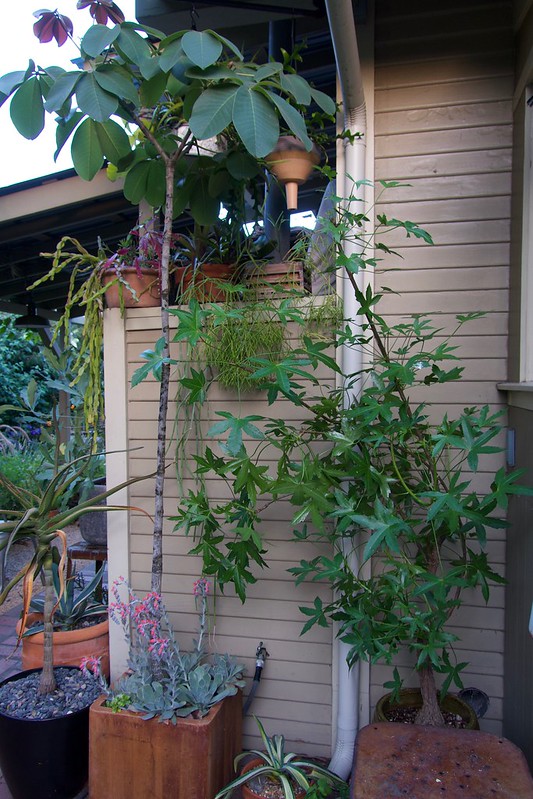
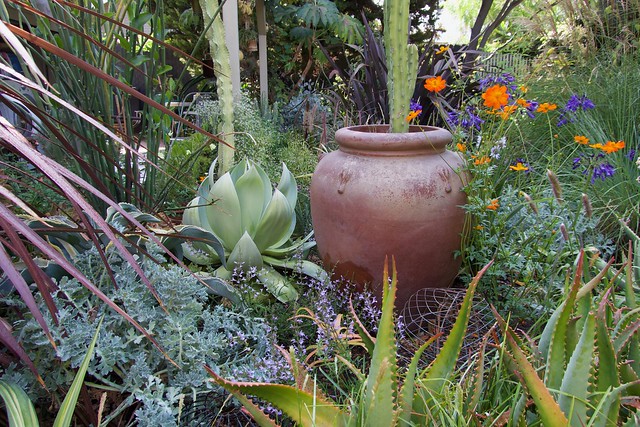

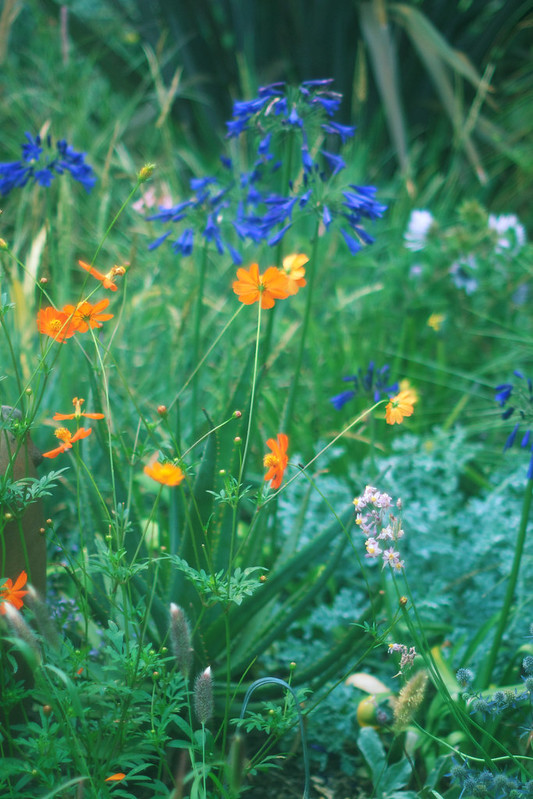

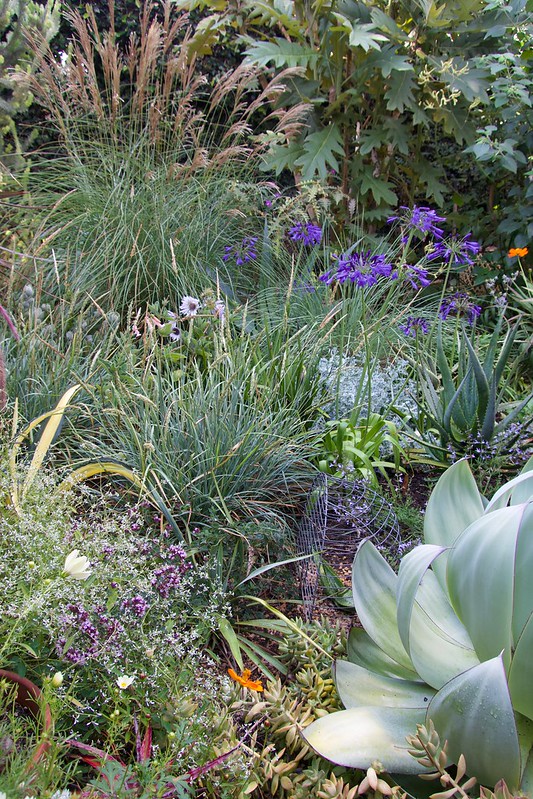
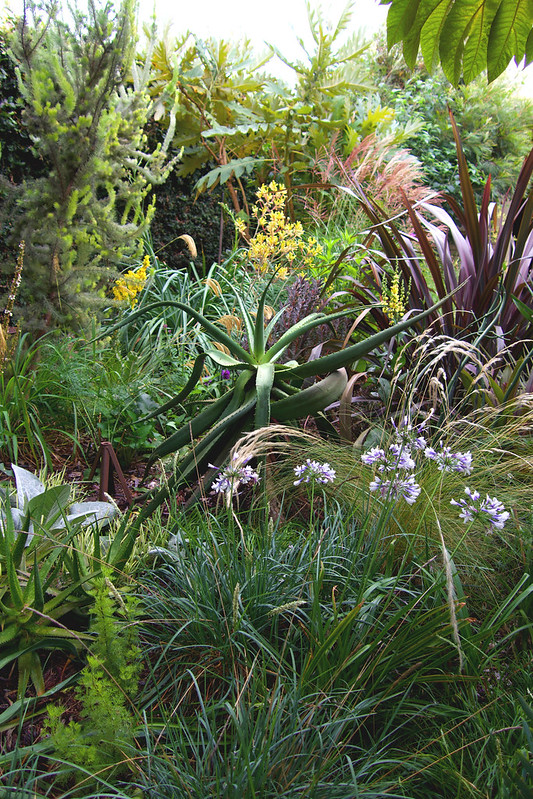
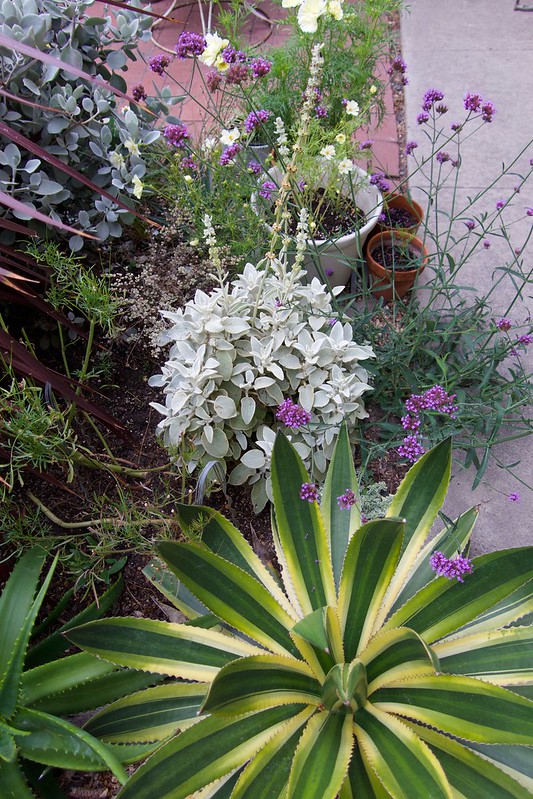
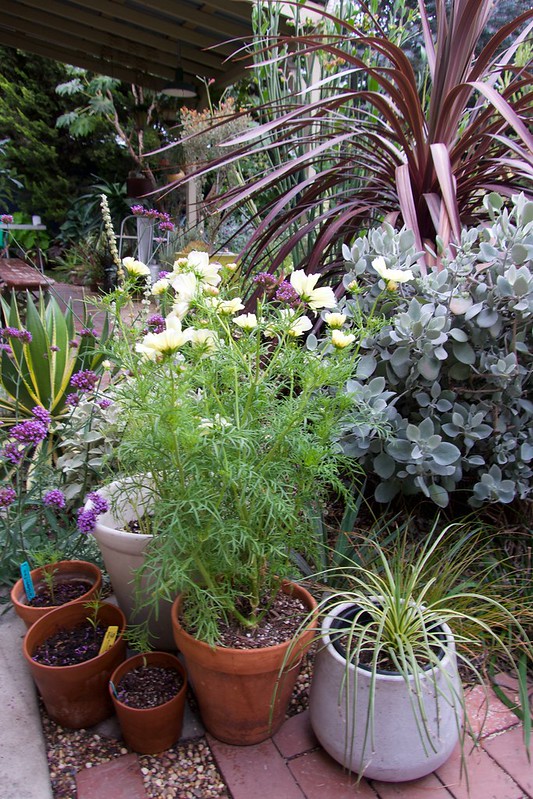
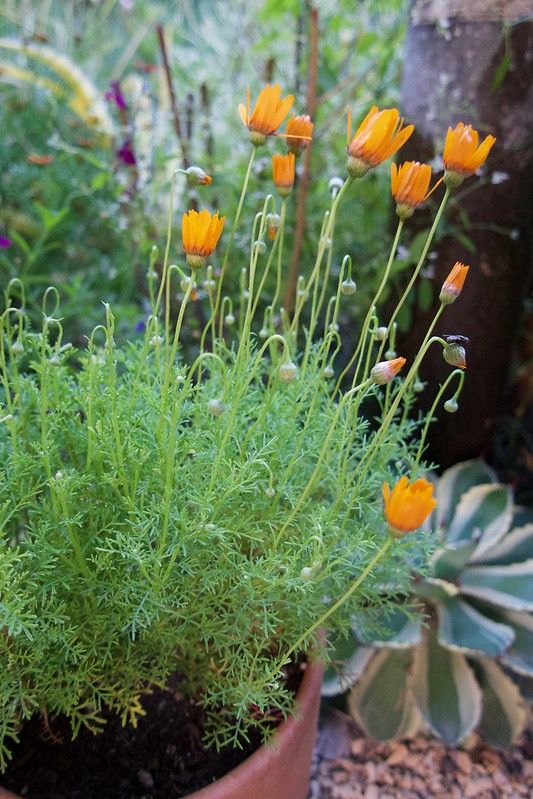
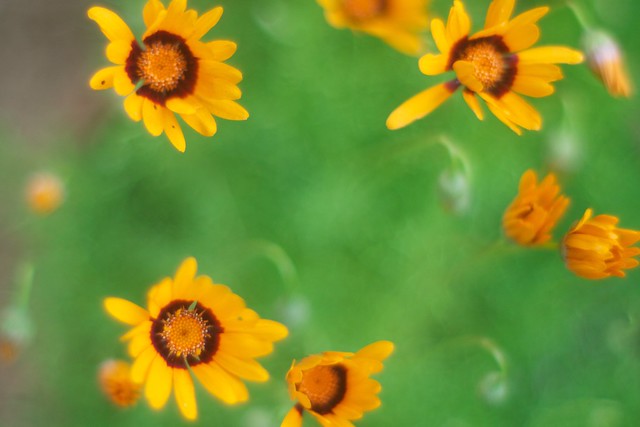
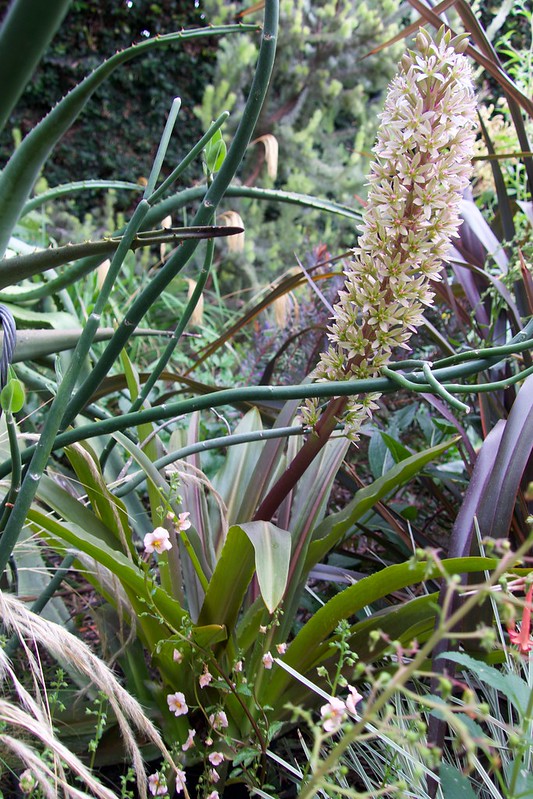
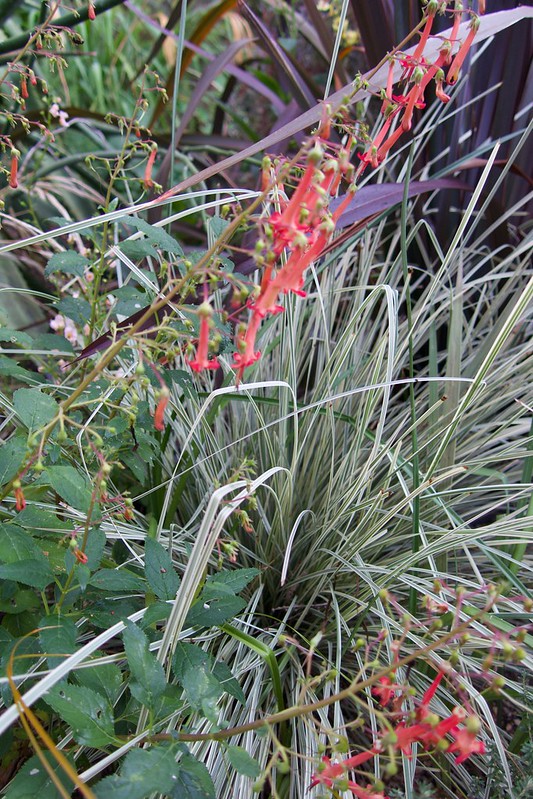
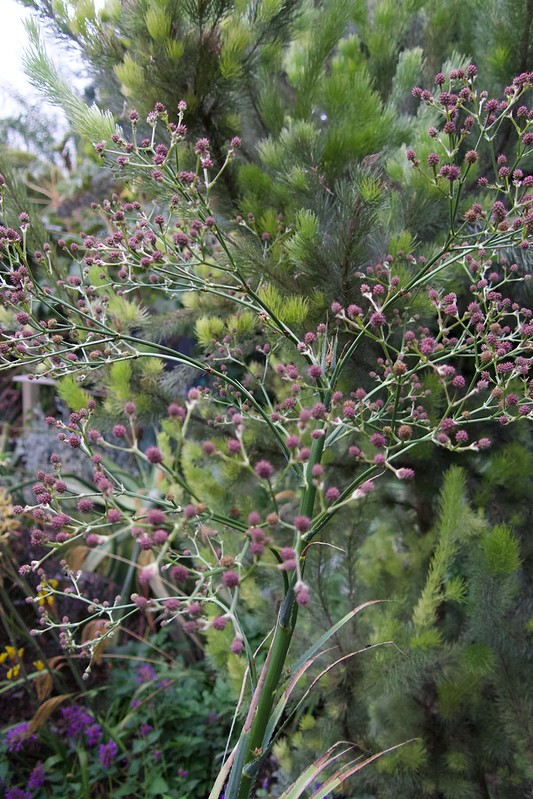

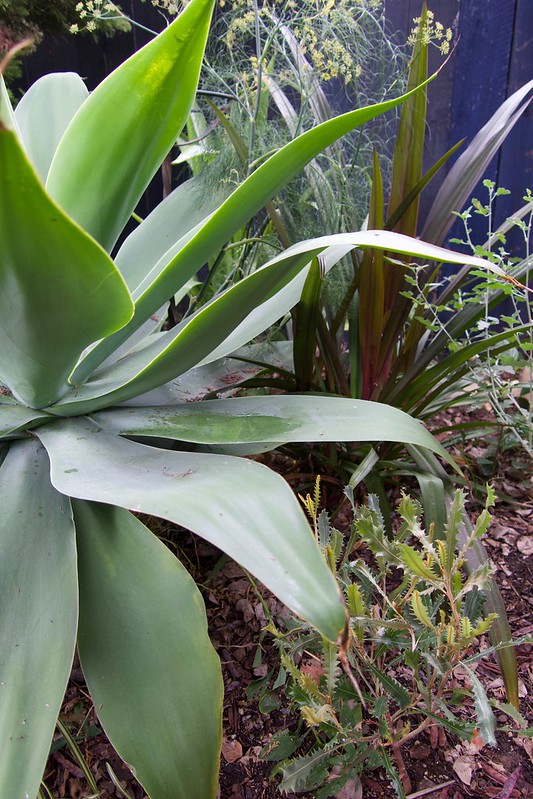
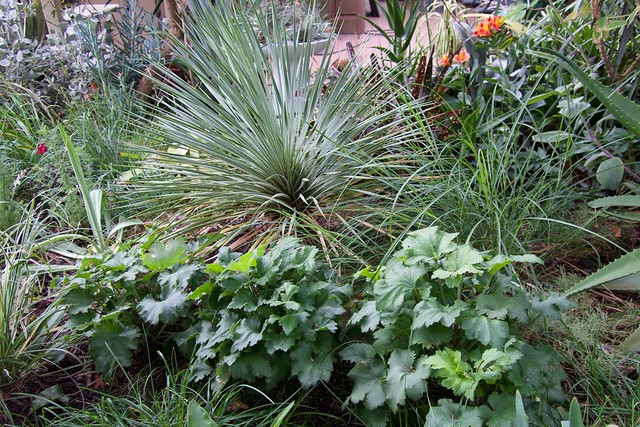
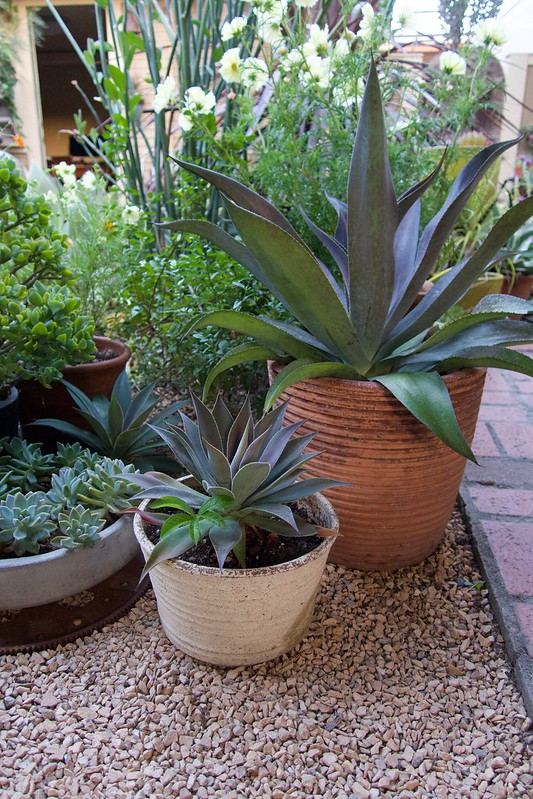
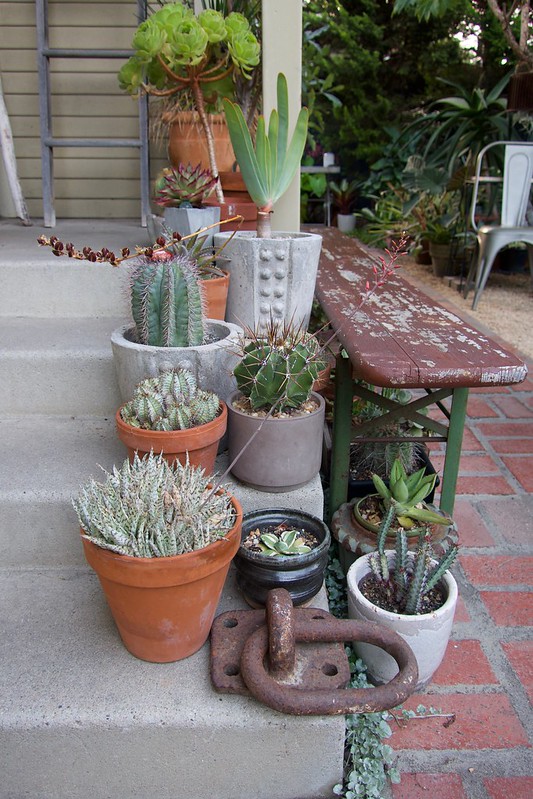

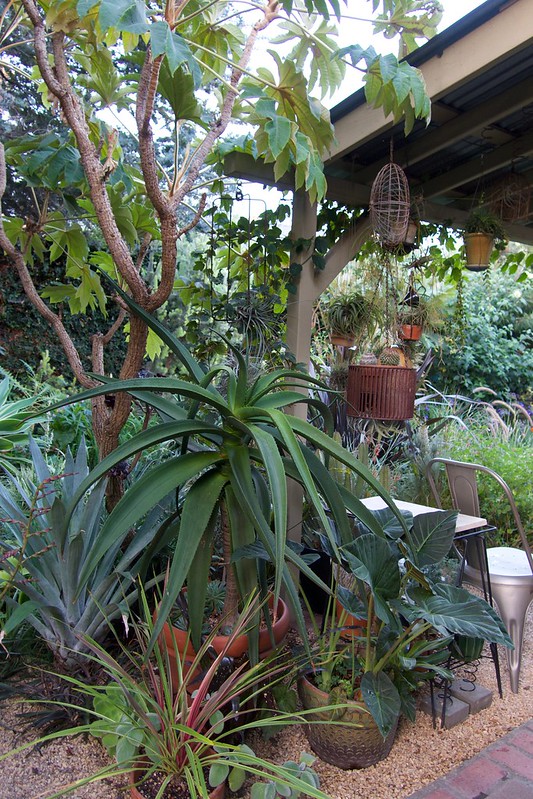
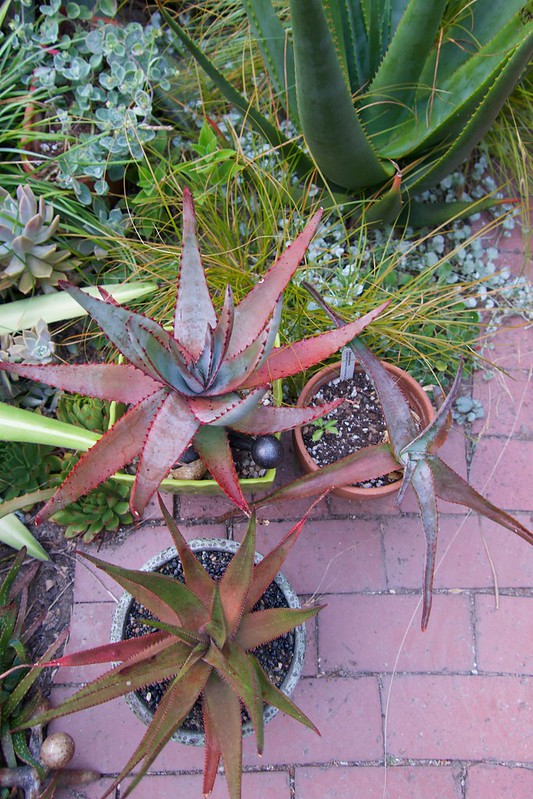
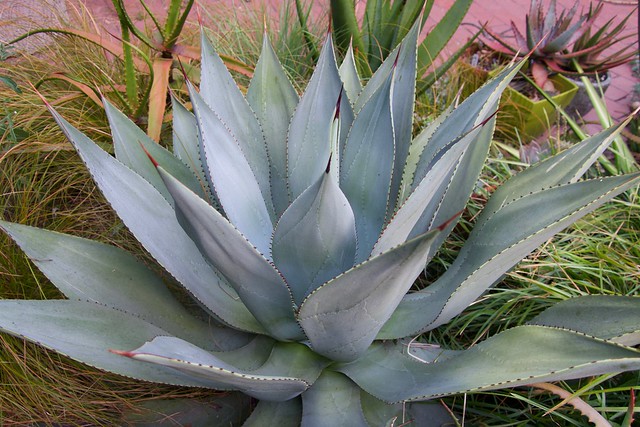
All looks wonderful. Your ability to be in the garden all day shows. Disappointed to hear you might take out Coreopsis ‘Tiger Stripes’ because it is sooooo gorgeous. Since seeing your earlier post I have been on the lookout for seeds.
Well, you have been busy! I’m guessing that your lifting restrictions may have been eased given all the plants you’ve moved about. I love all the touches of blue, purple and orange you’ve mixed in among your beloved succulents. Salvia ‘Savannah Blue’ looks like a winner and I’ll be looking out for it as I could stand to swap out some of the Salvias currently taking up space in my garden while adding little. Best wishes with the bathhouse refresh.
@Elaine, the ‘Tiger Stripes’ is an annual coreopsis so it’s gotta come out some time this summer! Chilterns has seeds of the annual coreopsis, and keep an eye out on Annie’s Annuals availability for selling plants again.
@Kris, I’ve gone all in with that Savannah Blue — if it only blooms a few weeks, it was a bad gamble. I’m still trying not to lift over 20 lbs but it’s hard to know until you do it!
You have been gardening! Some new plants–your scenes are beautiful and so varied. You’ve done great using annuals mixed in with dry garden stalwarts. Brava!
I tried Alonsoa one year–my garden was too hot for it. One bad heat wave and it was toast (literally).
The mystery Aloe looks like it has at least a little broomii in it.
15 years ?? Wow, I’m pretty sure I remember you sharing the development of the bathhouse, though whether it was the blog or Garden Web I don’t recall. How did 15 years go by ? I have longed for E. pandanifolium for years but now that I know where I can get one the size is an issue. What is the sun exposure on yours ?
@Hoov, thank you! I planted the alonsoa in shade/sun, and it was a 4-inch I found local, already flowering, which prompted ordering more. So glad you mentioned broomii — yes, the leaves do resemble it!
@Kathy, I thought the years seemed off, so I asked Marty. He’s been retired 10 years and built the bathhouse while he was still working. So he says it’s at least 12-15 years old. And the first parakeet landed exhausted on Duncan’s Miata, which he got in high school and Dune’s 32 now. If any of the rosettes of padan root I’ll set one aside for you. Mine is in a shade band in winter, sun in summer. A single rosette will bloom quickly in the garden, and then the clump goes on to make multiple rosettes that are on their own mystery timetable as to when each will bloom. Old bloomed out rosettes don’t die though. ‘Chelsea Psychic Purple’ is the strain to get for darkest flowers.
Thanks for this visit to your garden! I’d love a close-up someday of that Agave ‘Leapin’ Lizards,’ the leaves of geminiflora are so thin I can’t imagine how you could fit variegation on them.
That photo of the Eryngium pandanifolium in front of the Adenanthos sericeus is positively dreamy!
I love all your beautiful potted plants, especially the mangave collection. Feeling covetous now!